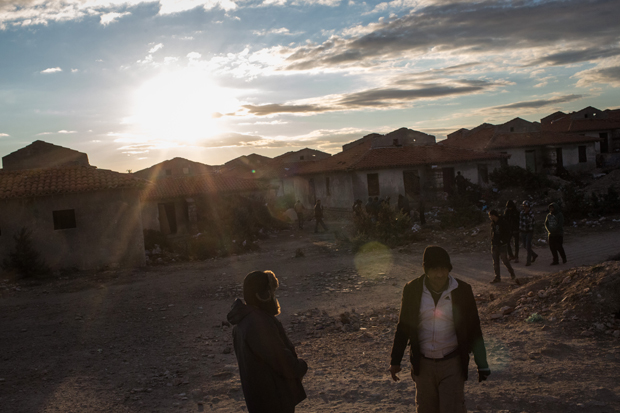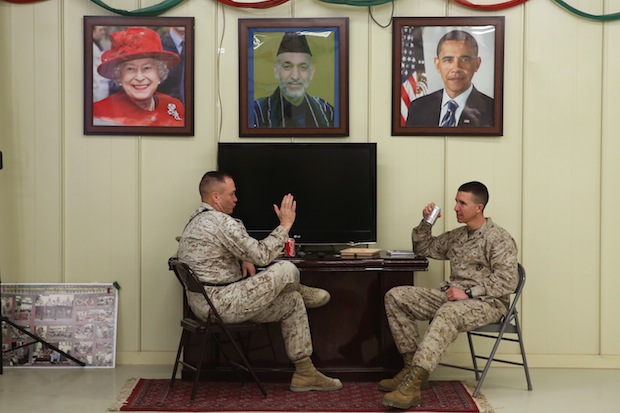Amid all the chaos in the Middle East, the breakdown of borders and states, a new threat is fast emerging. The key strategic bulwark to stabilise the region is a strong Afghanistan. But after 15 years of occupation by western troops and a trillion dollars spent, it now appears to be going the way of the Levant.
A weak government in Kabul has proved unable to forge a political consensus. The Taleban is resurgent, while other similar groups control much of the Afghan country-side. And this — with the potential spread factor of Isis — means that Afghanistan is probably worse off today than when foreign forces intervened in 2001. You will read very little about this problem, because Afghanistan is now regarded by most western leaders as an old problem, one that dogged their predecessors, one that they don’t want to confront. But expect to hear more about Afghanistan over the next year, because a bad situation is turning much worse.
Britain joined the United States mission in Afghanistan for a simple reason: to depose the Taleban and introduce a new, stable government. At the time, it was argued that the fanatics had managed to seize power in Kabul but there were plenty of moderate players who would, given a nudge from the West, take power again and return the nation to stability. It took more than a nudge: 456 British soldiers died during this mission and more than 2,200 Americans. The best that was achieved was the pretence of a stable government – which, it was hoped, would last for long enough for troops to withdraw.
The Taleban are now on their way back and recently captured their first city since losing the country to US forces in 2001. Kunduz, with a population of 300,000 and a strategic position on the border with Central Asia, had been under siege for much of this year, but a surprise attack by a few hundred Taleban just after a religious holiday overran its defences, and the security forces needed two weeks to retake the city.
Meanwhile, horrific bombing by US aircraft of a Kunduz hospital run by the international medical charity Médecins Sans Frontières, in which 30 people were killed (including 13 staff and three children), caused outrage around the world. The organisation rejected a US apology and demanded an international investigation. The Americans, lacking in ground intelligence, had mistaken the hospital for a Taleban compound. If such a mistake was possible, it could be repeated — a thought that has led to a large-scale evacuation of UN staff, western aid agencies and diplomats, further disabling humanitarian relief and jobs for Afghans across the country.
So how safe is Afghanistan now? American diplomats now travel only by helicopter for meetings even inside Kabul. The Taleban control almost all the major road systems in the country, which they could shut down when they choose, thereby isolating Kabul and other cities and preventing the supply of foodstuffs and trade from six neighbouring states.
Afghans now make up the second largest contingent of asylum-seekers arriving in Europe. According to UN statistics, they constitute almost 15 per cent of the total number of 650,000 who reached Europe between January and August. Many of them are well–educated middle-class families who held down good jobs as long as foreign forces were in their country.
And what are they fleeing? The world was shown a glimpse of it this last month when footage emerged of a young woman being stoned to death on charge of adultery. Once, such tales were recounted by western leaders as reason for intervening in Afghanistan. Now they are examples of what many Afghans fear is the state to come. Afghans who can afford to leave are doing so; some purchasing fake death-threat letters from the Taleban for as much as £700. Some 160,000 Afghans are expected to emigrate by the end of this year, quadruple the number of two years ago.
Officials in Kabul tell me that the Taleban pose a grave threat to more than half of the country’s 34 provinces. Of those, a half-dozen are in danger of falling completely into Taleban control, possibly when the spring offensive starts. They include Helmand in the south — the province that was under British control for so many years. Then there’s Faryab, an isolated but strategic province in the north-west bordering Turkmenistan; Farah in the south-west, bordering Iran; and Badakhshan and Kunar provinces in the north-east, bordering Pakistan and China. The fall of any one of these provinces would cause further panic in Kabul.
President Barack Obama’s decision in October to keep 5,500 US troops in Afghanistan beyond 2017 — when he had previously pledged that all US forces would leave before his term expires in just over a year — will ensure that the country is somewhere on the international agenda, but will not actually help defeat the Taleban. The promised number is little more than half the current strength of 9,800, which has been unable to stop the Taleban making their dramatic gains.
Some 4,000 Nato forces will also stay. Britain is one of several European countries that has pledged to maintain a small military presence alongside the Americans — probably around 500 troops. Sadly, Obama’s legacy to his successor is expected to be exactly the same as his from George W. Bush — an unresolved war and a critical military situation that threatens to destabilise the region.
The temporary loss of Kunduz triggered widespread alarm, especially in Central Asia, with Uzbekistan, Turkmenistan and Tajikistan deploying troops on their respective borders with Afghanistan. There is evidence that foreign fighters from Central Asia joined the Taleban for its attack on the town. Groups such as the Islamic Movement of Uzbekistan and the Eastern Turkestan Islamic Front (made up of Chinese Uighurs) are anxious to secure northern Afghanistan so that they can penetrate their own homelands. President Putin, speaking in Kazakhstan on 16 October, called on other ex-Soviet nations to be prepared to act together to repel a possible attack by ‘terrorists’ now seeking sanctuaries in Taleban-held areas of Afghanistan.
Meanwhile attempts by Pakistan to broker talks between the Kabul regime and the Taleban have collapsed after just one round taking place. After years of bitter antagonism between Pakistan and Afghanistan, Afghan President Ashraf Ghani and his co-ruler, Chief Executive Dr Abdullah Abdullah, had improved relations with Islamabad. And for the first time the powerful Pakistan military seemed anxious to end the neighbouring war and help broker a peace deal. The first round of talks, held on 7 July, was endorsed by China, the US and all of Afghanistan’s Central Asian neighbours. But further talks have been suspended amid the deteriorating military situation and disputes within the Taleban itself.
For the movement’s new leader, Mullah Akhtar Mansour, the current offensive was a shrewd political move. He faced internal opposition to his leadership — partly because he and six other Taleban kept it a secret that founding leader Mullah Mohammed Omar had died more than two years ago. Mansour had been ruling in Omar’s name for two years and building up his power base. But once the news broke, he lost the trust of many commanders and was shot during peace talks with them.
The divisions have already led to the emergence of several new splinter groups, with the power to denounce a peace process. Also accumulating territory and power in at least three provinces is Isis. They are largely made up of former Taleban disgusted with their own leaders, but they do seem to have connections and financial help from Isis leaders in Syria.
Meanwhile, lacking jobs or an effective state, Afghan refugees in Iran — mostly Shia Hazaras — are being recruited in large numbers by the Iranian military to fight in Syria alongside President Assad’s forces. They draw a monthly salary and have the chance of obtaining permanent residency in Iran. The Afghan military unit called Fatemioun is now the second largest foreign force in Syria after the Lebanese Hezbollah. Thus Afghanistan has, of its own account, crept into the Levant.
The tragedy is that the Afghan government is too weak to take advantage of the Taleban’s fragmentation or stop its citizens fighting other people’s wars. Though Ashraf Ghani’s government was formed following elections a year ago (which resulted in the power-sharing agreement with rival Abdullah), he has yet to appoint a defence minister or other ministers.
Daily governance has been brought to a standstill, with crucial projects such as scheduling parliamentary elections on indefinite hold. Meanwhile, the government has failed to tackle corruption and bolster the economy, and is literally running out of money. There is a large-scale flight of capital from Afghanistan — especially to the Gulf, where many citizens have bought houses. In Kabul there is intense political squabbling and many members of parliament are calling for the government’s resignation and the summoning of the ‘Loya Jirga’ (tribal body) to create a new interim government.
Unlike its Iraqi counterpart, which has largely collapsed in the face of Isis offensives, the regular Afghan army has proved it can fight. But it has taken heavy casualties: more than 5,000 Afghan security personnel have been killed so far in 2015, twice the number of the same period last year. Meanwhile, there are too many different security forces — regular troops, special forces, village guards and a variety of militias — leading a lack of central leadership and effective lines of command. The Afghan army also urgently needs more air cover. There is no proper Afghan air force and western governments have failed to provide one.
The West has lacked an overall strategy to contain the Taleban and help create a stable political order. This follows its earlier failure to convince Pakistan to abandon the Taleban many years ago. Obama has shown little personal interest in Afghanistan beyond doing what he has to do to prevent the total collapse of the state. Meanwhile, David Cameron and other European leaders have shown no initiative of their own.
At a regional conference hosted by Pakistan and Afghanistan in Islamabad on 9 December, all of Afghanistan’s neighbours including Pakistan pledged to take steps to end terrorism in the region and to help bring the Taleban to the table to hold talks with the Kabul government. It was the first time that Afghanistan’s President Ghani and Pakistan’s Prime Minister, Nawaz Sharif, had met and made up since the breakdown of their relations in July over Pakistan’s alleged continued support to the Taleban.
However, the day before the Taleban launched an attack on Kandahar airport where US and NATO forces are based. The fighting continued into the next day before all 14 of the attackers were killed. At least 37 Afghan civilians were killed and many more wounded. There were no reports of Western troop casualties.
At the same time – emphasising the growing fragmentation within the Taleban – there was heavy fighting in Afghanistan’s western Herat province in which more than 100 fighters were killed. The clashes were between between the mainstream Taleban group and a breakaway faction led by Mullah Mohammad Rasool.
Nonetheless, barring an unexpected return to the peace table, the spring will likely herald a nationwide Taleban offensive. The West is unlikely to come to the Afghan government’s rescue. The possibility of a Taleban return to power – in its southern heartland, at the very least – is no longer improbable.
The result will be further destabilisation of Pakistan and Central Asia, creating the perfect conditions for the expansion of the Islamic State. It’s not something anyone in London or Washington will want to admit, but after hundreds of lives lost in Afghanistan, and billions of dollars spent, the worst may well be yet to come.
Got something to add? Join the discussion and comment below.
Get 10 issues for just $10
Subscribe to The Spectator Australia today for the next 10 magazine issues, plus full online access, for just $10.
You might disagree with half of it, but you’ll enjoy reading all of it. Try your first month for free, then just $2 a week for the remainder of your first year.














Comments
Don't miss out
Join the conversation with other Spectator Australia readers. Subscribe to leave a comment.
SUBSCRIBEAlready a subscriber? Log in